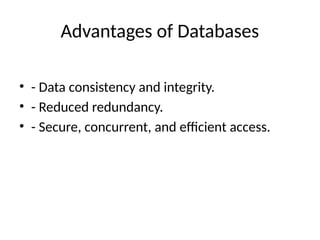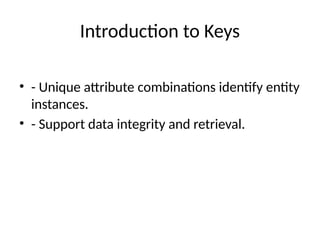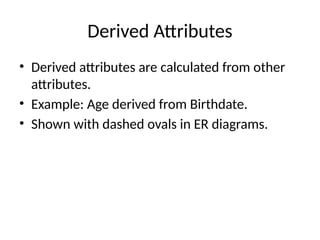database_design_presentation, data base design presenttion
- 1. Database Design An Introduction to Database Concepts and Design
- 2. Introduction to Databases • - A database is an organized collection of structured information. • - It allows efficient data retrieval, management, and storage. • - Examples: banking systems, e-commerce platforms, hospital records.
- 3. Comparison to File Systems • - File systems store data in separate files without connections. • - Difficult to handle large data volumes, redundancy, and consistency. • - Databases solve these problems with central management and structured access.
- 4. Problems with File Systems • - Redundancy and inconsistency. • - Difficulty in accessing and managing data. • - Poor security and lack of concurrency control.
- 5. Advantages of Databases • - Data consistency and integrity. • - Reduced redundancy. • - Secure, concurrent, and efficient access.
- 6. File System vs Database
- 7. Using Conceptual Data Models • - High-level models describe database structure without technical details. • - Entity-Relationship (ER) models focus on entities, attributes, and relationships.
- 8. Entity Types • - An entity type represents a class of objects. • - Example: Employee, Department, Student.
- 9. Entity Sets • - A collection of entities of the same type. • - Example: All employees in a company form the "Employee" entity set.
- 10. Attributes and Keys • - Attributes define properties of entities (e.g., Name, Age). • - Keys uniquely identify each entity (e.g., StudentID).
- 11. Relationship Types • - Define how entities are associated. • - Example: Employee "works for" Department.
- 12. Relationship Sets • - A collection of similar relationships. • - Example: All instances of "works for" relationships.
- 13. Roles in Relationships • - Roles clarify entity participation. • - Example: Supervisor and Subordinate in "Supervises" relationship.
- 14. Entities, Attributes, Relationships This Photo by Unknown Author is licensed under CC BY-SA
- 15. Structural Constraints • - Rules governing relationships (Cardinality: 1:1, 1:N, N:M). • - Participation constraints (total or partial).
- 16. Weak Entity Types • - Entities that depend on others for identification. • - Example: "Dependent" entity depends on "Employee" entity.
- 17. ER Diagrams • - Visual representation of entities, attributes, and relationships. • - Symbols: Rectangles (entities), Diamonds (relationships), Ovals (attributes).
- 18. Naming Conventions • - Use meaningful, consistent names. • - Entities: singular nouns; Relationships: verbs.
- 19. Introduction to Keys • - Unique attribute combinations identify entity instances. • - Support data integrity and retrieval.
- 20. ER Diagram with Weak Entity This Photo by Unknown Author is licensed under CC BY-SA
- 21. Total vs Partial Participation • Total Participation: Every entity instance must participate (double line). • Partial Participation: Some instances may not participate (single line). • Example: Every employee must work in a department (total participation).
- 22. Cardinality Ratios Explained • One-to-One (1:1): Each entity in A is related to at most one entity in B. • One-to-Many (1:N): One entity in A is related to many entities in B. • Many-to-Many (M:N): Many entities in A relate to many in B.
- 23. Composite Attributes • Composite attributes can be divided into smaller sub-parts. • Example: Address → Street, City, Zip Code. • Useful for detailed information modeling.
- 24. Multivalued Attributes • Multivalued attributes can have multiple values for a single entity. • Example: An employee with multiple phone numbers. • Represented with double ovals in ER diagrams.
- 25. Derived Attributes • Derived attributes are calculated from other attributes. • Example: Age derived from Birthdate. • Shown with dashed ovals in ER diagrams.
- 26. Identifying Relationships • An identifying relationship links a weak entity to its strong entity. • The weak entity's table includes a foreign key from the strong entity. • Ensures data consistency and dependency.
- 27. Generalization vs Specialization • Generalization: Bottom-up approach (combine entities). • Specialization: Top-down approach (divide into sub-entities). • Helps in managing inheritance among entities.
- 28. ER-to-Relational Mapping: 1:1 • For 1:1 relationships, the primary key of one relation becomes the foreign key in another. • Optionally merge both relations if participation is total on both sides.
- 29. ER-to-Relational Mapping: 1:N • For 1:N relationships, place the foreign key in the relation on the 'N' side (many side). • Example: Many employees belong to one department.
- 30. ER-to-Relational Mapping: M:N • For M:N relationships, create a new table. • This table holds foreign keys referencing the primary keys of the two related entities. • Example: Students enrolled in Courses.





























